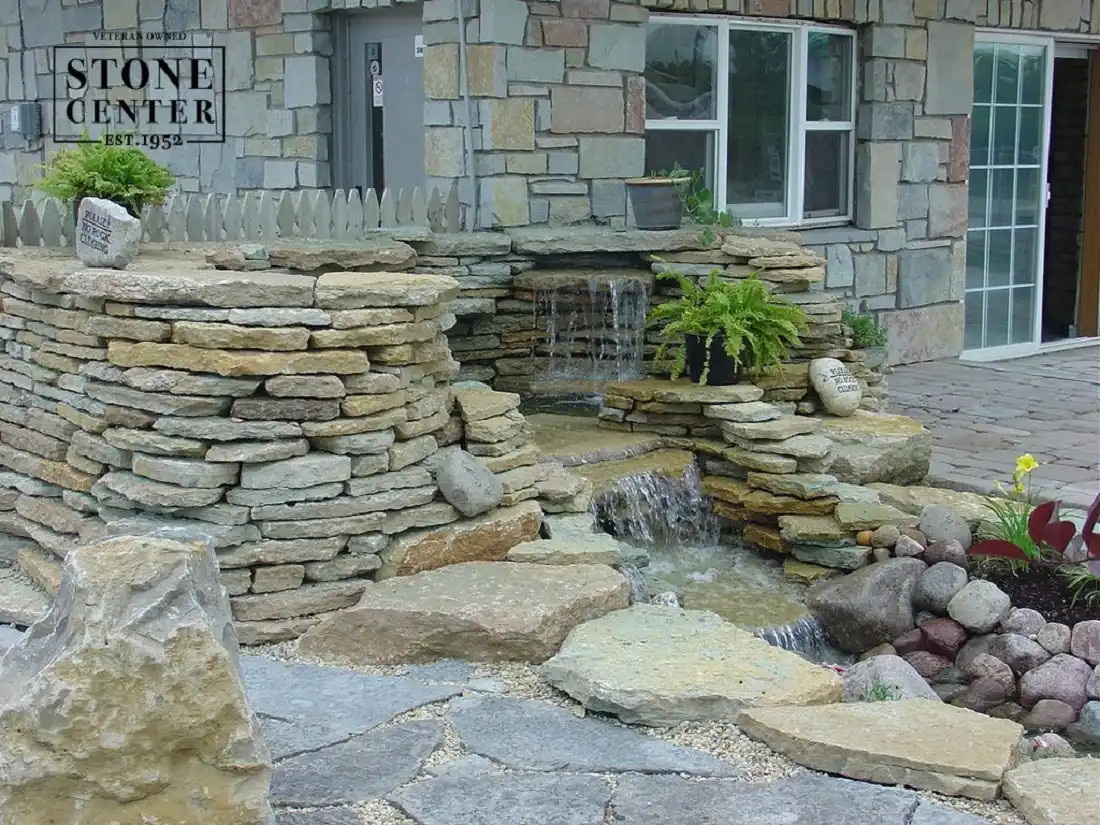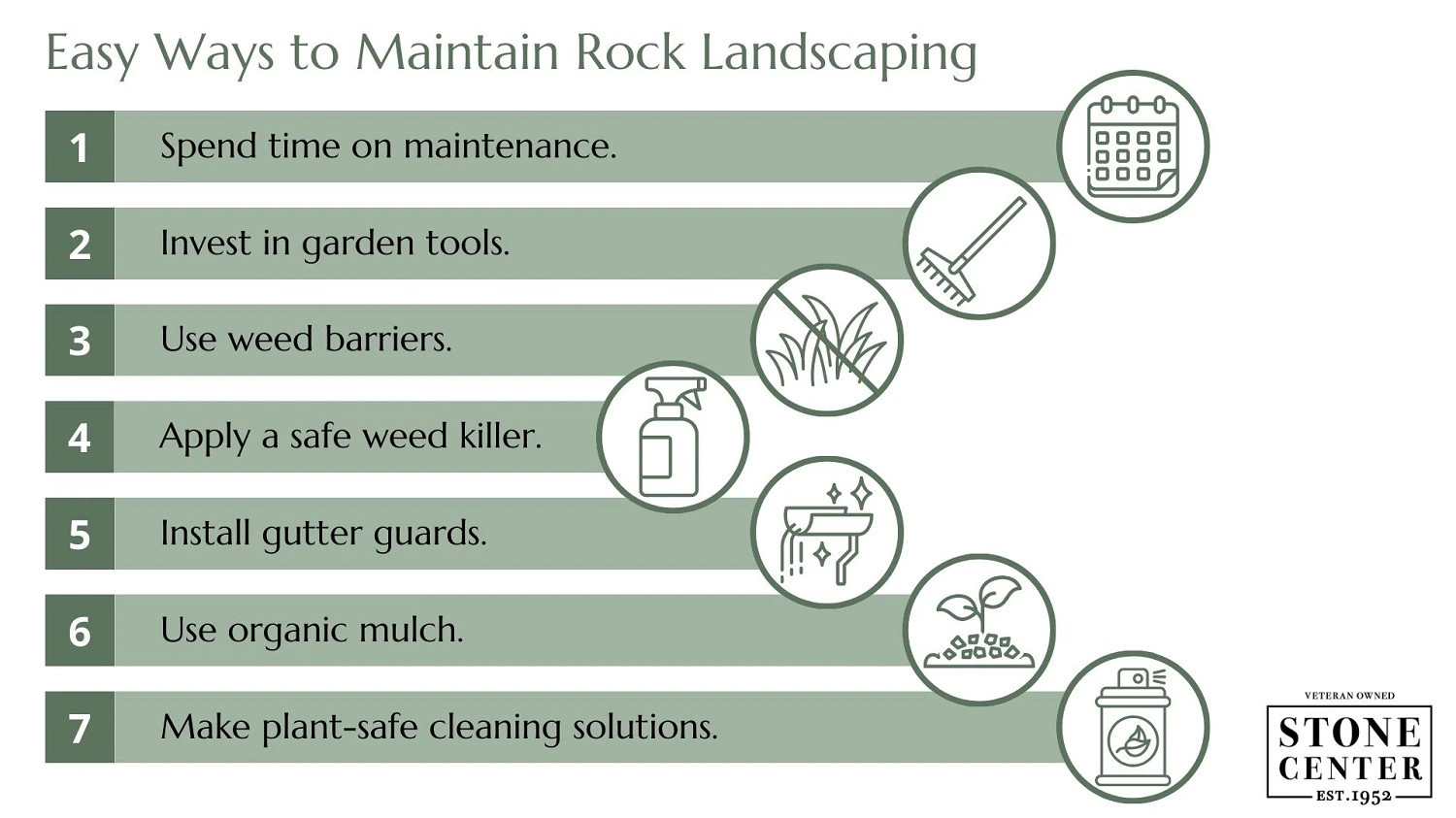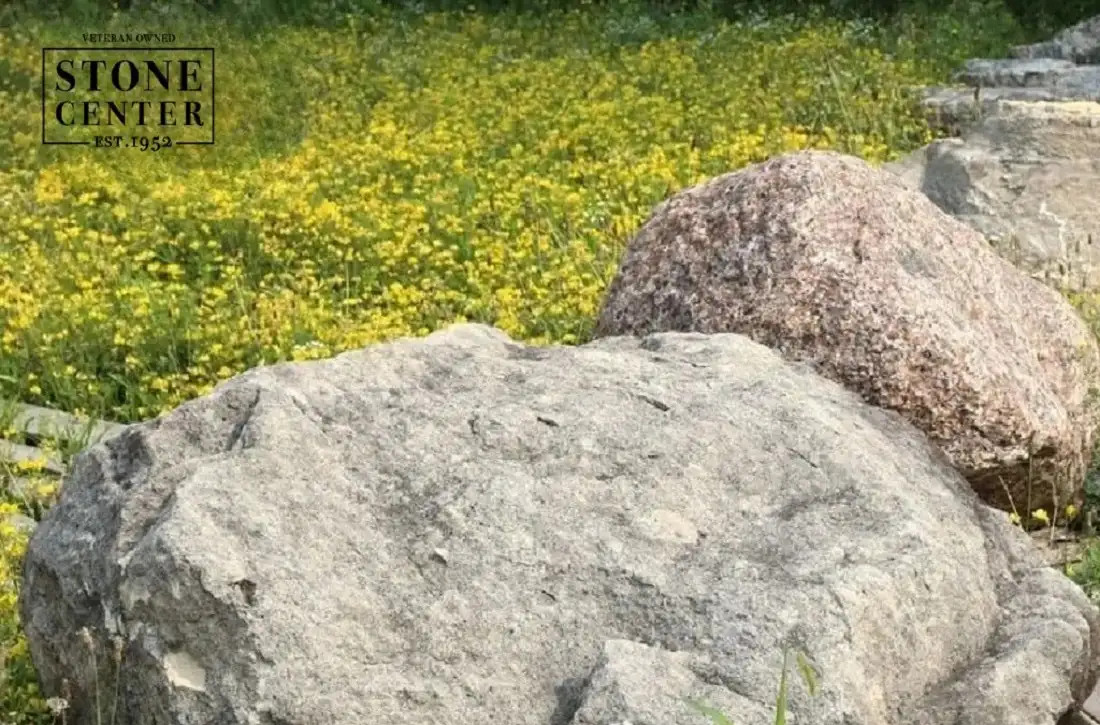Cleaning river rock in landscaping is crucial for maintaining its beauty and preventing issues like algae growth. This comprehensive guide from rockscapes.net provides detailed steps and tips to keep your river rock looking pristine.
1. Understanding the Importance of Cleaning River Rock
River rock, with its smooth, natural appearance, is a popular choice for landscaping. However, exposure to the elements can lead to the accumulation of dirt, debris, and unsightly algae. Regular cleaning is essential for maintaining the aesthetic appeal and longevity of your river rock features. It’s not just about looks; clean river rock contributes to a healthier landscape. Neglecting maintenance can lead to clogged drainage systems, weed infestations, and a generally unkempt appearance.
1.1 Why Clean River Rock?
Cleaning river rock is important for several reasons:
- Aesthetic Appeal: Removes dirt, algae, and stains, restoring the natural beauty of the rocks.
- Weed Prevention: Eliminates organic matter that can support weed growth.
- Improved Drainage: Keeps rocks free of debris that can clog drainage systems.
- Pest Control: Reduces habitats for pests by removing decaying organic material.
- Extended Lifespan: Prevents deterioration and damage caused by prolonged exposure to the elements.
1.2 Recognizing When to Clean
How often should you clean your river rock? The frequency depends on several factors, including the local climate, the amount of shade the rocks receive, and the proximity to trees and other vegetation. In general, look for these signs that indicate it’s time for a cleaning:
- Visible Dirt and Debris: A buildup of dirt, leaves, and other organic matter.
- Algae or Moss Growth: Green or slimy patches on the surface of the rocks.
- Faded Color: A dull or faded appearance compared to when the rocks were first installed.
- Unpleasant Odors: Musty or earthy smells emanating from the rocks.
- Poor Drainage: Water pooling on the surface of the rocks after rain.
2. Essential Tools and Materials for Cleaning River Rock
Before you begin, gather the necessary tools and materials to make the cleaning process efficient and effective. Having everything on hand will save you time and effort.
2.1 Tools
- Garden Hose with Adjustable Nozzle: For rinsing and washing the rocks.
- Stiff-Bristle Brush or Broom: For scrubbing away dirt, algae, and stains.
- Soft-Bristle Brush: For delicate surfaces or detailed cleaning.
- Bucket: For mixing cleaning solutions.
- Protective Gloves: To protect your hands from chemicals and rough surfaces.
- Rake or Leaf Blower: For removing loose debris before cleaning.
- Small Brush or Old Toothbrush: For cleaning crevices and hard-to-reach areas.
- Pressure Washer (Optional): For more efficient cleaning of large areas.
2.2 Cleaning Solutions
- Mild Dish Soap and Water: A general-purpose cleaner for light dirt and grime.
- White Vinegar and Water (1:1 Ratio): An eco-friendly solution for algae and stains. According to research from Arizona State University’s School of Earth and Space Exploration, in July 2025, vinegar provides an effective way to control algae growth.
- Baking Soda Paste: For stubborn stains and buildup.
- Hydrogen Peroxide: For whitening and removing stains (use with caution on colored rocks).
- Bleach Solution (Use Cautiously: 1 Part Bleach to 10 Parts Water): For heavily soiled rocks, but avoid overuse to prevent discoloration.
3. Step-by-Step Guide to Cleaning River Rock
Follow these steps to effectively clean your river rock landscaping and restore its natural beauty. Each step is designed to address specific cleaning needs, ensuring a thorough and long-lasting result.
3.1 Preparing the Area
Before you start cleaning, prepare the area around the river rocks. This involves removing any furniture, decorations, or other items that might obstruct your cleaning process. Clear away loose debris like leaves, twigs, and weeds using a rake or leaf blower. Preparing the area ensures that you can focus on cleaning the rocks without any hindrances.
3.2 Rinsing the Rocks
Use a garden hose with an adjustable nozzle to rinse off the rocks. Start at the top of the area and work your way down, allowing the water to flow away from the clean sections. This initial rinse removes loose dirt and debris, making the subsequent cleaning steps more effective. If you’re using a pressure washer, be sure to wear gloves and safety goggles for protection.
3.3 Scrubbing the Rocks
Create a mild cleaning solution by mixing water and a gentle detergent in a bucket. Dip a stiff-bristle brush or broom into the solution and scrub the rocks, focusing on any areas with visible stains or algae growth. For stubborn stains, use a mixture of equal parts water and white vinegar. Be sure to scrub every surface of the rocks to ensure a comprehensive clean.
 Scrubbing river rocks
Scrubbing river rocks
3.4 Cleaning Crevices and Hard-to-Reach Areas
River rocks often have small crevices and indentations that can trap dirt and debris. To clean these areas, use a small brush or toothbrush dipped in your cleaning solution. Gently scrub the crevices, removing any dirt or buildup that may be present. A thorough cleaning of these areas can significantly improve the overall appearance of your river rock.
3.5 Rinsing the Rocks Again
Use your garden hose and any power-washing tool to rinse the rocks again. Be sure to rinse thoroughly, as any remaining detergent can cause a slippery surface and harm your plants. A thorough rinse ensures that no cleaning solution remains, which is especially important if you’re using stronger chemicals like bleach.
3.6 Allowing the Rocks to Dry
Give your rocks time to air dry — the drying process will help prevent water damage to the structure. If you’re in a hurry, you can use a leaf blower or a dry towel to remove excess moisture from the rocks. Allowing the rocks to dry completely helps to prevent the re-growth of algae and moss.
3.7 Consider Sealing Your Rocks
A quality stone sealer can prevent algae growth and make future cleaning easier. Choose a water-based sealer safe for aquatic life if your rocks are near ponds or water features. Sealing the rocks provides an extra layer of protection against the elements and makes maintenance simpler in the long run.
4. Specific Cleaning Methods for Different Types of River Rock
Different types of river rock may require specific cleaning approaches due to their unique characteristics. Understanding these differences can help you choose the most effective cleaning method.
4.1 Cleaning Polished River Rock
Polished river rock has a smooth, shiny surface that can be easily scratched by abrasive cleaners or brushes. Use a soft-bristle brush and a mild soap solution to clean polished river rock. Avoid using harsh chemicals or pressure washers, as they can damage the polished surface. Regular gentle cleaning is the best way to maintain the appearance of polished river rock.
4.2 Cleaning Natural River Rock
Natural river rock has a more rugged, textured surface that can withstand more aggressive cleaning methods. Use a stiff-bristle brush and a mixture of white vinegar and water to clean natural river rock. Pressure washing can also be effective, but be careful not to damage the rocks or surrounding plants. Natural river rock benefits from thorough cleaning to remove dirt and algae from its textured surface.
4.3 Cleaning River Rock with Algae Growth
Algae growth can be a common problem, especially in shaded or damp areas. To clean river rock with algae growth, use a solution of bleach and water (1 part bleach to 10 parts water). Apply the solution to the affected areas and let it sit for a few minutes before scrubbing with a stiff-bristle brush. Rinse thoroughly with water. Be cautious when using bleach, as it can harm plants and animals. According to research from Arizona State University’s School of Earth and Space Exploration, in July 2025, bleach provides an effective way to control algae growth.
4.4 Cleaning River Rock with Mineral Deposits
Mineral deposits, such as calcium or lime, can leave unsightly stains on river rock. To remove mineral deposits, use a solution of muriatic acid and water (follow manufacturer’s instructions for proper dilution). Apply the solution to the affected areas and let it sit for a few minutes before scrubbing with a stiff-bristle brush. Rinse thoroughly with water. Muriatic acid is a strong chemical, so use it with caution and wear protective gear.
5. Eco-Friendly Cleaning Solutions
For those who prefer environmentally friendly options, several natural cleaning solutions can be used to clean river rock. These solutions are safe for plants, animals, and the environment.
5.1 White Vinegar and Water
A mixture of equal parts white vinegar and water is an effective cleaner for algae, stains, and general dirt. Vinegar is a natural disinfectant and can help to prevent the growth of mold and mildew. Simply spray the solution on the rocks, let it sit for a few minutes, and then scrub with a brush.
5.2 Baking Soda Paste
Baking soda can be used to create a paste for removing stubborn stains. Mix baking soda with water until you have a thick paste, then apply it to the stained areas. Let the paste sit for a few minutes before scrubbing with a brush and rinsing with water. Baking soda is a gentle abrasive and can help to lift stains without damaging the rocks.
5.3 Hydrogen Peroxide
Hydrogen peroxide is a mild bleaching agent that can be used to whiten and remove stains from river rock. Mix one part 3 percent hydrogen peroxide with two parts water and apply to the stained areas. Let the solution sit for a few minutes before rinsing with water. Use hydrogen peroxide with caution on colored rocks, as it can cause fading.
 Eco-friendly cleaning solutions
Eco-friendly cleaning solutions
6. Preventing Future Buildup
Preventing future buildup of dirt, algae, and stains is just as important as cleaning river rock. Implementing preventive measures can reduce the frequency of cleaning and keep your river rock looking its best.
6.1 Regular Maintenance
Regular maintenance is key to preventing buildup. Inspect your river rock landscaping regularly and remove any loose debris, such as leaves, twigs, and weeds. This simple task can prevent organic matter from decomposing and staining the rocks.
6.2 Proper Drainage
Ensure that your river rock landscaping has proper drainage. Poor drainage can lead to water pooling, which creates a breeding ground for algae and moss. Make sure that the area is sloped properly and that there are no obstructions in the drainage pathways.
6.3 Sunlight Exposure
Sunlight can help to prevent the growth of algae and moss. If possible, choose a location for your river rock landscaping that receives plenty of sunlight. If the area is shaded, consider pruning nearby trees or shrubs to allow more sunlight to reach the rocks.
6.4 Stone Sealers
Applying a stone sealer can help to protect river rock from stains, algae, and mineral deposits. Choose a sealer that is specifically designed for use on natural stone and that is safe for plants and animals. Follow the manufacturer’s instructions for proper application.
7. Addressing Common Problems
Even with regular cleaning and maintenance, you may encounter some common problems with river rock landscaping. Here are some tips for addressing these issues.
7.1 Weed Growth
Weed growth can be a persistent problem in river rock landscaping. To prevent weed growth, use a weed barrier fabric underneath the rocks. If weeds do appear, pull them by hand or use a safe weed killer. Be careful when using weed killers, as they can harm desirable plants.
7.2 Insect Infestations
River rock landscaping can provide a habitat for insects, such as ants, spiders, and beetles. To prevent insect infestations, remove any decaying organic matter from the rocks. You can also use an insecticide specifically designed for outdoor use. Follow the manufacturer’s instructions for proper application and safety precautions.
7.3 Discoloration
Discoloration can occur due to mineral deposits, stains, or exposure to the elements. To remove discoloration, try using a solution of muriatic acid and water or a commercial stone cleaner. Always test the cleaner on a small, inconspicuous area first to ensure that it does not damage the rocks.
8. Creative Uses for Clean River Rock in Landscaping
Once your river rock is clean, you can explore various creative ways to use it in your landscaping. Clean river rock can enhance the beauty and functionality of your outdoor spaces.
8.1 Garden Pathways
Create charming garden pathways using clean river rock. These pathways add texture and visual interest to your garden while providing a stable and attractive walking surface.
8.2 Dry Riverbeds
Design a dry riverbed feature using clean river rock to mimic a natural watercourse. This adds a unique element to your landscape and can also help with drainage.
8.3 Rock Gardens
Incorporate clean river rock into rock gardens, combining it with drought-tolerant plants and other decorative stones to create a low-maintenance and visually appealing landscape.
8.4 Water Features
Use clean river rock around ponds, fountains, and other water features to create a natural and cohesive look. The rocks can help to prevent erosion and provide a habitat for aquatic life.
 Creative river rock landscaping
Creative river rock landscaping
9. Tips for Maintaining River Rock in Different Climates
The climate in your region can significantly affect how you maintain your river rock landscaping. Here are some tips for different climates.
9.1 Arid Climates
In arid climates, water conservation is essential. Use drought-tolerant plants in your river rock landscaping and consider using a drip irrigation system to water them efficiently. Clean the rocks regularly to prevent dust buildup.
9.2 Humid Climates
In humid climates, algae and moss growth can be a common problem. Clean the rocks more frequently and ensure that the area has good drainage. Consider using a stone sealer to protect the rocks from moisture.
9.3 Cold Climates
In cold climates, protect your river rock landscaping from freeze-thaw cycles, which can cause the rocks to crack or shift. Remove any snow and ice from the rocks and consider using a de-icing agent that is safe for natural stone.
9.4 Coastal Climates
In coastal climates, salt spray can damage river rock. Rinse the rocks regularly with fresh water to remove salt buildup. Choose plants that are salt-tolerant for your river rock landscaping.
10. Why Choose Rockscapes.net for Your Landscaping Needs
Maintaining beautiful river rock landscaping requires the right knowledge and resources. At rockscapes.net, we offer a wealth of information, inspiration, and products to help you create and maintain stunning outdoor spaces.
10.1 Expert Advice and Guidance
Our website provides expert advice and guidance on all aspects of landscaping, from choosing the right materials to implementing effective maintenance strategies. Whether you’re a seasoned landscaper or a DIY enthusiast, you’ll find valuable information to help you succeed.
10.2 High-Quality Products
We offer a wide selection of high-quality landscaping products, including river rock, decorative stones, sealers, and cleaning solutions. Our products are sourced from trusted suppliers and are designed to withstand the elements and provide long-lasting beauty.
10.3 Inspiring Design Ideas
Discover inspiring design ideas for incorporating river rock into your landscaping. Our website features a gallery of stunning projects that showcase the versatility and beauty of natural stone.
10.4 Local Expertise
Located at 1151 S Forest Ave, Tempe, AZ 85281, United States, and reachable by phone at +1 (480) 965-9011, rockscapes.net understands the unique challenges and opportunities of landscaping in Arizona and the surrounding areas. Our team of experts can provide personalized recommendations and solutions to meet your specific needs.
10.5 Call to Action
Ready to transform your outdoor space with beautiful, clean river rock? Visit rockscapes.net today to explore our wide selection of products, discover inspiring design ideas, and get expert advice from our team. Contact us to learn more and start your landscaping journey.
FAQ: Cleaning River Rock in Landscaping
1. What is the best way to clean river rock in landscaping?
The best way to clean river rock involves removing debris, rinsing with water, scrubbing with a mild soap solution, cleaning crevices with a small brush, rinsing thoroughly, and allowing the rocks to dry.
2. How often should I clean river rock in my garden?
Clean river rock every 1-2 years, or more frequently if you notice significant dirt, algae, or debris buildup.
3. Can I use a pressure washer to clean river rock?
Yes, but use caution to avoid damaging the rocks or surrounding plants. Wear protective gear and use a wide nozzle setting.
4. What is the best cleaning solution for river rock?
A mild solution of dish soap and water works well for general cleaning. For algae and stains, use a mixture of white vinegar and water.
5. How can I prevent algae growth on river rock?
Ensure good drainage, provide sunlight exposure, and consider applying a stone sealer to prevent algae growth.
6. Is it safe to use bleach to clean river rock?
Yes, but use cautiously. Mix 1 part bleach with 10 parts water and apply to affected areas, then rinse thoroughly.
7. How do I clean mineral deposits from river rock?
Use a solution of muriatic acid and water, following the manufacturer’s instructions for proper dilution and safety precautions.
8. Can I use eco-friendly cleaning solutions for river rock?
Yes, white vinegar and water, baking soda paste, and hydrogen peroxide are all effective and eco-friendly options.
9. How do I remove weeds from river rock landscaping?
Use a weed barrier fabric underneath the rocks. Pull weeds by hand or use a safe weed killer when necessary.
10. What should I do after cleaning my river rocks?
Allow the rocks to dry completely, and consider applying a stone sealer for added protection against future buildup.
